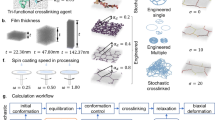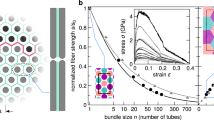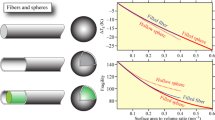Abstract
Polymer materials of reduced size and dimensionality, such as thin films, polymer nanofibres and nanotubes, exhibit exceptional mechanical properties compared with those of their macroscopic counterparts. We discuss here the abrupt increase in Young's modulus in polymer nanofibres. Using scaling estimation we show that this effect occurs when, in the amorphous (non-crystalline) part of the nanofibres, the transversal size of regions consisting of orientation-correlated macromolecules is comparable to the nanofibre diameter, thereby resulting in confinement of the supramolecular structure. We suggest that in polymer nanofibres the resulting supramolecular microstructure plays a more dominant role in the deformation process than previously thought, challenging the commonly held view that surface effects are most significant. The concept we develop also provides a way to interpret the observed—but not yet understood—temperature dependence of Young's modulus in nanofibres of different diameters.
This is a preview of subscription content, access via your institution
Access options
Subscribe to this journal
Receive 12 print issues and online access
$259.00 per year
only $21.58 per issue
Buy this article
- Purchase on Springer Link
- Instant access to full article PDF
Prices may be subject to local taxes which are calculated during checkout





Similar content being viewed by others
References
Reneker, D. H. & Fong, H. (eds) Polymeric Nanofibers 7–20 (ACS, Washington DC, 2005).
Vaia, R. A. & Wagner, H. D. Polymer nanocomposites: Framework for the future. Mater. Today 7(11), 32–37 (2004).
Zussman, E., Burman, M., Yarin, A. L., Khalfin, R. & Cohen, Y. Tensile deformation of electrospun nylon-6,6 nanofibers. J. Polym. Sci. B 44, 1482–1489 (2006).
Yu, M. F. et al. Strength and breaking mechanism of multiwalled carbon nanotubes under tensile load. Science. 287, 637–640 (2000).
Cuenot, S., Demoustier-Champagne, S. & Nysten, B. Elastic modulus of polypyrrole nanotubes. Phys. Rev. Lett. 85, 1690–1693 (2000).
Ji, Y., Li, B., Ge, Sh., Sokolov, J. C. & Rafailovich, M. H. Structure and nanomechanical characterization of electrospun PS/clay nanocomposite fibers. Langmuir 22, 1321–1328 (2006).
Cuenot, S., Frétigny, Ch., Demoustier-Champagne, S. & Nysten, B. Surface tension effect on the mechanical properties of nanomaterials measured by atomic force microscopy. Phys. Rev. B 69, 165410 (2004).
Dingreville, R., Qu, J. M. & Cherkaoui, M. Surface free energy and its effect on the elastic behavior of nano-sized particles, wires and films. J. Mech. Phys. Solid 53, 1827–1854 (2005).
Arinstein, A. E. Orientationally correlated random walks and statistics of rigid-chain polymer molecules. Sov. Phys. JETP 91, 206–225 (2000).
Mezikovskii, S. M., Arinstein, A. E. & Deberdeev, R. Ja. The Oligomeric State of the Material (in Russian) (Nauka, Moscow, 2005).
De Gennes, P. G. Scaling Concepts in the Physics of Polymers. (Cornell Univ. Press, Ithaca, 1979).
Onsager, L. The effects of shapes on the interaction of colloidal particles. Ann. NY Acad. Sci. 51, 627–659 (1949).
Khokhlov, A. R. & Semenov, A. N. On the theory of liquid-crystalline ordering of polymer chains with limited flexibility. J. Stat. Phys. 38, 161–182 (1985).
Neway, B. et al. Free volume and transport properties of homogeneous poly(ethylene-co-octene)s. Polymer 45, 3913–3922 (2004).
Acknowledgements
This work was partly supported by the Russell Berrie Nanotechnology Institute, the Glasberg–Klein Research Fund and the Israel Science Foundation (grant 597/06 and grant 486/05).
Author information
Authors and Affiliations
Corresponding author
Ethics declarations
Competing interests
The authors declare no competing financial interests.
Supplementary information
Rights and permissions
About this article
Cite this article
Arinstein, A., Burman, M., Gendelman, O. et al. Effect of supramolecular structure on polymer nanofibre elasticity. Nature Nanotech 2, 59–62 (2007). https://doi.org/10.1038/nnano.2006.172
Received:
Accepted:
Published:
Issue Date:
DOI: https://doi.org/10.1038/nnano.2006.172
This article is cited by
-
In-situ forming dynamic covalently crosslinked nanofibers with one-pot closed-loop recyclability
Nature Communications (2023)
-
Comparison of Physical Properties and Degradation of Polylactic Acid and Polypropylene Facemask Layer
Fibers and Polymers (2023)
-
Electrospun Nanocomposite Scaffold Based on Polycaprolactone-decellularized Umbilical Cord Wharton’s Jelly/Multi-walled Carbon Nanotubes: A Biomimetic Substrate for Articular Cartilage Tissue Engineering
Journal of Polymers and the Environment (2023)
-
The Mechanical Behaviors of Polyethylene/Silver Nanoparticle Composites: an Insight from Molecular Dynamics study
Scientific Reports (2020)
-
Water cast film formability of sugarcane bagasse xylans favored by side groups
Cellulose (2020)



